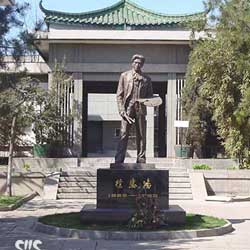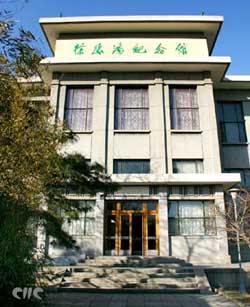
Xu Beihong (1895-1953) was an outstanding Chinese artist and educator of the fine arts. His works cover a wide range of styles and mediums, though he is best known for his horse paintings.
The Xu Beihong Museum was originally housed near the Beijing Railway Station. In 1953 Xu' s wife, Mrs. Liao Jingwen, contributed the residence and his entire collection of books, calligraphy, and paintings to the country. Later, due to subway renovations, the museum was moved to 53 North Xinjiekou Street, the former location of Liu Qiyuan' s personal chrysanthemum collection.
The museum displays Mr. Xu' s studio as it was originally arranged. Among the wall hangings are the master' s copy of the Western European oil painting "Bountiful Harvest," traditional Chinese paintings by Ren Bonian and Qi Baishi, and a photo of Mr. Xu with the Indian poet and philosopher Tagore. Also on display are the master' s seals, ancient artifacts, and gifts given by foreign friends.
Photos include shots from Mr. Xu' s trips to the former Soviet Union and Czechoslovakia, Italy and India. Copies of letters from the Chinese People' S volunteers and elementary school students, telegrams and original letters of condolence sent after the master' s death are also on display.

In the exhibition hall are color ink paintings, oil paintings, and sketches from each period of Mr. Xu's career. His explosive, daring "Galloping Horse" symbolizes beauty and power. The inscription says: "I'm agitated about the battle in Changsha on August 10, 1941. Will it end as the first? I hope so." The master completed this work in the autumn of 1941 in Singapore, where he went to raise funds for the War of Resistance Against Japan.
The Xu Beihong collection is comprised largely of works collected by the master, works from the Tang, Song, Yuan, Ming, and Qing dynasties up to the May 4th Movement of 1919. All together, there are over 1,200 art objects, 10,000 ancient books, stone inscription rubbings, bronze vessel rubbings, and prints. Include is an expensive Tang painting "Eighty-seven Immortals" by Wu Daozi, a famous Tang Dynasty painter, which the master purchased in Hong Kong in 1938.
Add: No.53, North Xinjiekou Street;
Entry ticket: 5 yuan;
Opening hours: 9:00 AM -- 4:00 PM;
Transport: Bus No.s 22, 38, 47, 626, 726, 409, 709, 810 and 826;
Tel: 86-10-62252042.
(China.org.cn September 20, 2005)
|

